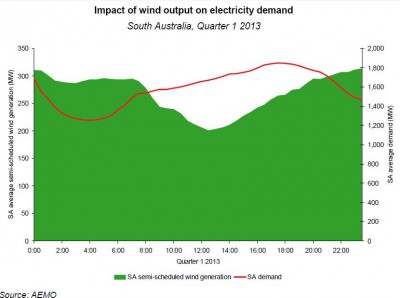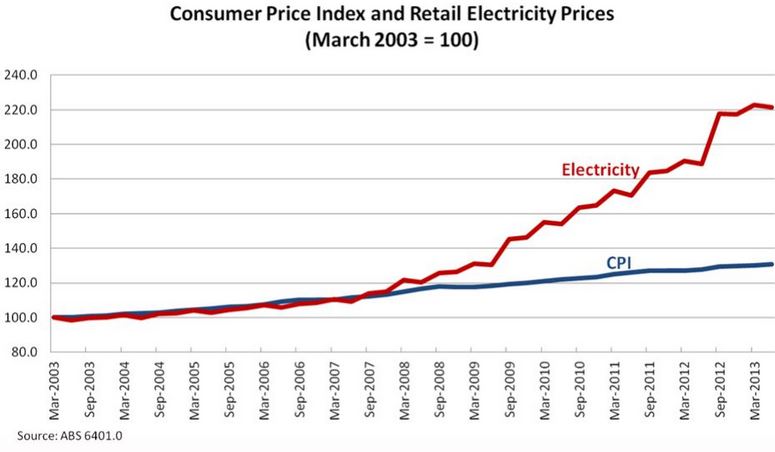
STT followers have a keen ear when it comes to picking wind industry spin.
One of the most fantastic efforts to turn night into day is the completely bogus story about wind power causing a reduction in Australian retail power prices. Like most wind industry drivel, it’s a tale that’s heavy on emotional “belief” and light on cold hard facts. The greentard wants to believe that wind power is free; and the rent seekers that trade on greentard political support are happy to fuel the delusion.
The focus is always placed on wholesale prices – about which power punters – who are lumped with the retail price – couldn’t care less.
True it is that – on those rare occasions (usually at night when there’s no demand for it) when the wind happens to be blowing (see our post here) – the occasional addition of wind power to an over-supplied grid depresses the wholesale market. So much so, wind power outfits will happily dispatch to the grid at prices approaching zero, even paying the grid manager to take their power, because they enjoy guaranteed returns fixed under Power Purchase Agreements (see our post here).

The wind industry and its parasites bang-on long and loud about the mandatory Large-Scale RET lowering power prices, while steering well clear of the actual cost of wind power to retailers. However, it’s a yarn that suffers from at least two minor flaws:
1 – nowhere in Australia have retail power prices decreased.
In fact, retail power prices continue to increase at rates double the rate of increase in the Consumer Price Index. Thanks to its ludicrous efforts to “rely” on wind power – South Australians pay the highest retail power prices in the world (see our post here). Last year, Queenslanders got walloped with a 23% increase in retail power prices in just 12 months (see our post here).
And 2 – thanks to the rates set under PPAs, wind power costs retailers 3-4 times the average wholesale price.
The spin masters never, ever talk about the prices fixed under Power Purchase Agreements between wind power outfits and retailers – set at $90-120 per MWh versus $30-40 for conventional power – and recovered from retail customers, irrespective of the wholesale price (see our post here); and they run a mile from any mention of the Renewable Energy Certificates that get directed to wind power outfits at power consumer expense (see our post here).
The LRET sets up the greatest wealth transfer in the history of the Commonwealth. However, it’s not one that power consumers are going to thank their political betters for. That transfer – which comes at the expense of the poorest and most vulnerable; struggling businesses; and cash-strapped families – is effected by the issue, sale and surrender of RECs. As Origin Energy chief executive Grant King correctly puts it:
“[T]he subsidy is the REC, and the REC certificate is acquitted at the retail level and is included in the retail price of electricity”.
It’s power consumers that get lumped with the “retail price of electricity” and, therefore, the cost of the REC Subsidy paid to wind power outfits. The REC Tax/Subsidy has already added $9 billion to Australian power bills, so far.
Between 2014 and 2031, the mandatory LRET requires power consumers to pay the cost of issuing 603.1 million RECs to wind power generators. With the REC price likely to be at least $65 (by 2017) – and tipped to exceed $90 – the wealth transfer from power consumers to the wind industry will be somewhere between $40 billion and $60 billion, over the next 17 years (see our posts here and here).
The true facts about the LRET and power prices haven’t been lost on Australia’s miners. Rock scratching uses a mountain of power (see our post here) and processing the stuff that’s won from Australia’s wide brown land uses even more (see our post here).
So you’d tend to think that these boys would know a little about power prices. Here’s The Australian skewering the wind industry’s favourite furhpy about the LRET lowering power prices.
RET costs causing a heavy burden: miners
The Australian
Sid Maher
9 October 2014
MINERS have moved to counter arguments from the renewable energy industry that the target scheme is lowering electricity prices, releasing figures showing it is costing millions of dollars and comprising up to 15 per cent of total electricity bills.
A briefing sent to MPs interested in the renewable energy target debate, circulated by the Minerals Council of Australia, shows six coalmines in Queensland and NSW paid a combined $7.7 million in RET costs last year and $7.3m in 2012.
The proportion that the RET charge made up of the total bill ranged from 9 per cent to 12 per cent last year, and between 12 per cent and 15 per cent in 2012. This is significantly higher than the 4 per cent average cost to house-holds because large users receive a discounted electricity price for buying in bulk.
The document has been circulated to MPs ahead of negotiations between the Coalition and Labor on the future of the scheme.
Cabinet this week gave Environment Minister Greg Hunt and Industry Minister Ian Macfarlane a negotiating mandate to reach a deal with Labor that is in line with longstanding Coalition policy. This would see aluminium granted a full exemption and likely see the government push for a cut to the RET from 26 per cent of electricity demand in 2020 to about 20 per cent.
Labor has opposed large cuts to the RET and has accused the government of jeopardising investment by abandoning bipartisan support for the scheme.
The minerals council document, which was sent to MPs on all sides, says claims the RET is reducing the cost of electricity to households and industrial users are false.
The document examined the costs of six coalmines in NSW and Queensland and its conclusions were based on invoices from electricity retailers.
It said $15m burden over two years “is not shared by Australia’s competitors in global markets. Energy costs should be an aspect of Australia’s competitive advantage in international markets not a source of disadvantage.’’
In a second case study, a minerals processing operation that received a partial exemption still faced a net cost of $26m over three years, but the proportion of the electricity bill was about 4 per cent.
The Australian
Australia’s recent growth in incomes, wealth – and its prosperity generally – has a fair bit to do with the profitability of our miners, which is why – when miners talk – the Federal government tends to listen (see our post here).
While the numbers put forward by the miners are worrying enough, they ignore the cost of the LRET from here on. This is one case where focusing on the rear-view mirror means you’ll lose sight of the road ahead.
The annual target set by the LRET has been relatively benign in the first decade or so of its operation. The target is set annually by s40 of the Renewable Energy (Electricity) Act 2000 (Cth):
|
Required GWh of renewable source electricity |
|
|
Year |
GWh |
|
2001 |
300 |
|
2002 |
1100 |
|
2003 |
1800 |
|
2004 |
2600 |
|
2005 |
3400 |
|
2006 |
4500 |
|
2007 |
5600 |
|
2008 |
6800 |
|
2009 |
8100 |
|
2010 |
12500 |
|
2011 |
10400 |
|
2012 |
12300 |
|
2013 |
14200 |
|
2014 |
16100 |
|
2015 |
18000 |
|
2016 |
22600 |
|
2017 |
27200 |
|
2018 |
31800 |
|
2019 |
36400 |
|
2020 |
41000 |
|
2021 |
41000 |
|
2022 |
41000 |
|
2023 |
41000 |
|
2024 |
41000 |
|
2025 |
41000 |
|
2026 |
41000 |
|
2027 |
41000 |
|
2028 |
41000 |
|
2029 |
41000 |
|
2030 |
41000 |
It’s only after 2015 that the target starts to rocket to its grand total of 41,000 GWh in 2020 – where it sits for the decade after that.
As well as focusing on the (irrelevant) wholesale price, another piece of wind industry subterfuge is to point to what it claims is the average cost of the LRET per household. But the figures are all based on what apppears in the rear-view mirror.
From s40 it’s plain enough that satisfying the target has been a relatively modest task to date. But from 2016, the gentle slope becomes an insurmountable rock-face.
Satisfying the target requires retailers to purchase and surrender RECs in rapidly increasing numbers (see above). In the (highly likely) event that retailers are unable (or unwilling) to purchase sufficient RECs to satisfy the target they will be hit instead with a $65 per MWh fine for every MW they fall below the mandated annual target: what’s called the “shortfall charge” – follow the links here and here. The cost of that fine will be added to retail power bills and recovered from power consumers; households and miners alike (see our post here).
Miners, policy makers and the rest of us should worry less about what’s been; and get a grip on what’s to come. While a rear view will safely pick up the fact that the LRET has cost power consumers around $9 billion in REC Tax/Subsidy so far, it requires a little forward focus to see the $50 billion in REC Tax looming on the horizon, that will be added to power bills from here on.
If Australia wants a viable mining and mineral processing sector as part of its future our political betters need to get a grip on the future cost of the LRET – and to take the axe to the most expensive and pointless policy in Australia’s history.



We continue to inform people about this ludicrous situation, but they don’t listen and don’t want to listen because they are frozen in a time warp, they are frozen to the opportunities that are there to create a less polluted and more pleasant environment, without destroying the life style and opportunities achieved and created so far. They have become frozen to a false hope, a dream, a theory that has shown not to be what it was said to be, what these people need to keep in mind is the following saying:
‘Ask yourself always: How can this be done better?’
GC LITCHENBERG
and maybe, just maybe they will see what others have been saying is true, and that there are other ways to achieve their hopes and dreams without making life intolerable for many and deprived of a safe healthy environment for others.
They may then put their ‘energy’ to better use.
A much needed better defining of the rort.
I think further to this, one must reiterate that the REC purchase is a tax deduction, while the shortfall charge is not tax deductible and guess who collects the shortfall charge?……………the government of the day.
Also, my understanding is the producers (a public bureaucratic body) of each individual REC make money from said production.
This is so criminal that the mafiosa would blush.
More than that the Italian criminal prosecution body, another government funded body, prosecuted the mafia for getting in on the act. No room for competition there.
But as the public bureaucrats would say “Hey it’s nothing personal, it’s just business”.
Ned Kelly was a gentleman compared to these windweasel and greentard goons.